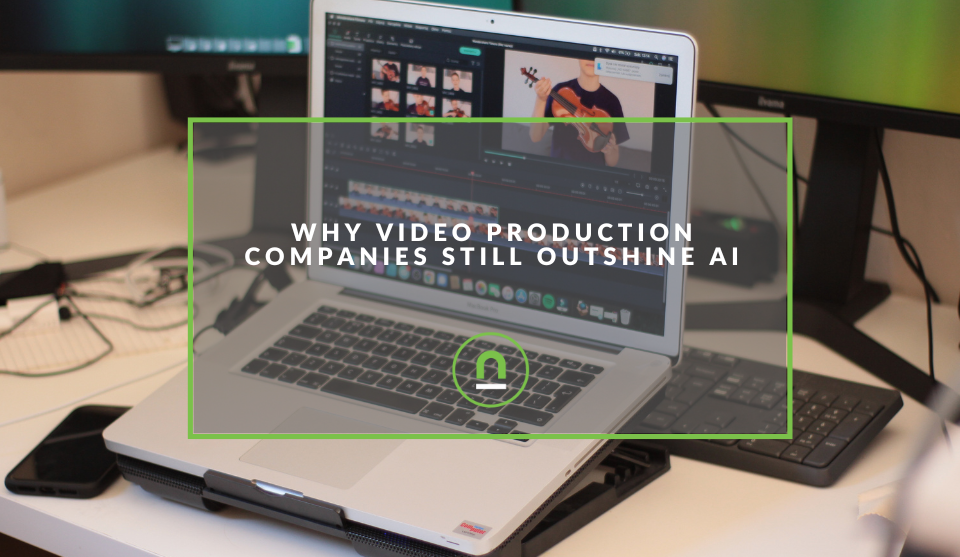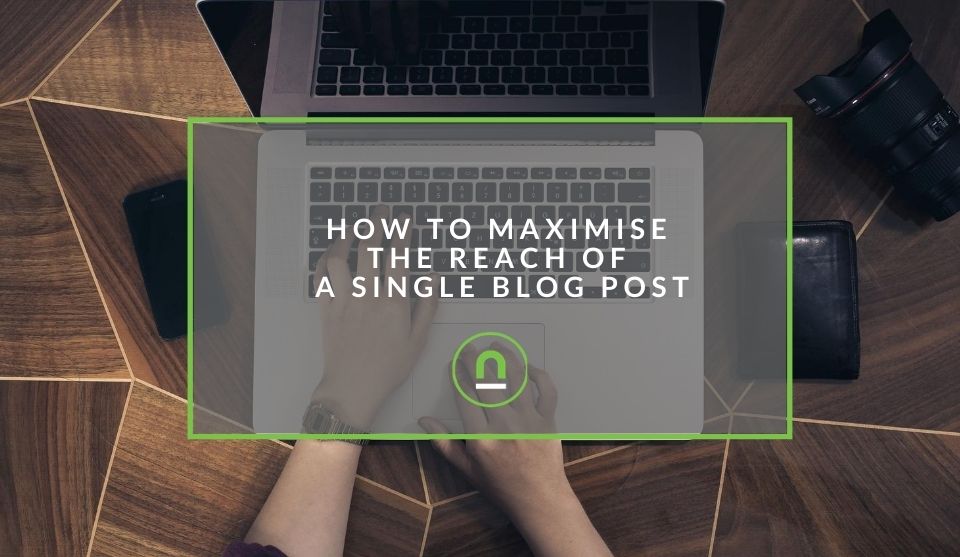Recent posts

Ace of Trades
The South African Industrial Tech Revolution
05 January 2026

nichemarket Advice
Why Video Production Companies Still Outshine AI
24 December 2025

Press Releases
Where You Can Find International Remote Jobs For South Africans
23 December 2025

Money Talks
Why Cross-Border Payments Are Slow, Tedious, and Expensive
17 December 2025
Popular posts
Extravaganza
Trending Music Hashtags To Get Your Posts Noticed
24 August 2018
Geek Chic
How To Fix iPhone/iPad Only Charging In Certain Positions
05 July 2020
Extravaganza
Trending Wedding Hashtags To Get Your Posts Noticed
18 September 2018
Money Talks
How To Find Coupons & Vouchers Online In South Africa
28 March 2019
How To Maximise The Reach Of A Single Blog Post
10 August 2020 | 1 comments | Posted by Che Kohler in nichemarket Advice
So you've put in the time, done your keyword research bucketed them into topics and used that as the base for forming the worlds most epic blog post on a topic you're passionate about and have an in-depth knowledge of the subject matter. You've inserted the keywords you want to rank for strategically, formatted the content in a way that's easy for readers to skim and for crawlers to understand for indexing.
Next, you've reviewed your competitors, and you feel your content is far better and more relevant to readers than what is currently available.
But your post is the new kid on the block, how will Google find it and understand it needs to be ranking number one? You have no history to go on, and if you're in a competitive niche, you're going to need more than just a well-written blog post to get those rankings you crave and feel your content deserves.
Most bloggers tend to post and forget, or perhaps share it on their social media accounts, and that's where posts go to die.
Amplification is key
As great as Google and Bing crawlers are, they need to put up with reviewing millions of pieces of content each day and ranking it for relevant queries. They consider thousands of factors that are constantly changing so they can re-order rankings to me as helpful as possible to various user queries.
One day for you to give your content a boost is to tell search engines,
"hey look at me, look what I made".
Yes just like showing off your crayon drawings to mum would it posted up on the fridge, search engines also value self-promotion and amplification.
If you're stuck for ideas on how to amplify your content outside a good tweet and Facebook share, then check out nichemarkets complete guide to content amplification.
Organic social media
When looking to amplify your content, it's always good to start with the freebies and try to leverage your current organic reach. Once you've exhausted all your free options, you can then feel confident that this is the floor and breaking out the credit card will bring in some good traffic to your posts.
1. Facebook post
Ah yes, the Facebook post, the cornerstone of all amplification of any content and probably the most popular method on the list. If you don't have a business page, I encourage you to set one up immediately and start gathering a following. You can share your content on your business page and then reshare on your private Facebook account; you can also get your friends, family and employees involved and use shares and engagement to amplify your posts.
2. Facebook tagging
Next on your list of possible ways to reach new users is to tag brand pages or individuals either in your post or in the comments. Tagged accounts will receive a notification and would encourage them to check out your post; they could then reshare it to their audience. Remember to use this technique with some description, so you don't annoy users or brands and see yourself blocked.
3. Facebook group post
Facebook groups are the last remaining place on the platform that does not use algorithmic curation of content and is a great way to get more eyes on your content. First, you will need to find the relevant groups that would be interested in your content and gain access to these groups, speak to admins or read the instructions as not to spam the groups and risk getting removed.
4. Facebook Messenger
Facebook Messenger is an untapped resource for reaching out to users and one way to bypass Facebook's tricky curation. If you know of individuals on Facebook that may be interested in your content and have not reacted to it, pop them a DM on Messenger and ask them to check out your new post. You can also create group chats in messenger to make it more comfortable to spread your links to more interested users, keyword being interested.
Again, don't go spamming people or you will be blocked.
5. Twitter
Twitter would naturally be the platform many heads towards for sharing content, its where the conversation happens online and at a frantic pace. Twitter is a cruel mistress, and your posts will only reach more users if you have a solid user base, to begin with, that are willing to interact and retweet your content.
Remember also to leverage hashtags to try and slot your content into popular streams and hopefully grab the attention of additional users.
6. Twitter tagging
As mentioned previously, you need your user base to engage with you, unlike Facebook, Twitter tagging is pretty common, so here you have more freedom to tag. Still, also you're limited so you may need to leverage comments should you have plenty of users to tag.
Tagging can get you a lot more views should you tag people with an active audience.
7. Twitter DMs
Not as popular as Messenger but still an avenue worth pursuing, especially since users get a direct email should they receive a Twitter DM. Pick your outreach wisely, write a thoughtful DM message before adding your link in and explain why you're reaching out and what you would like from the reader, to comment, to lend their opinion or to reshare your post.
Again, use it wisely, or you will be blocked, and the exercise may end up being counterproductive.
8. Linkedin
Ah yes, everyone's favourite job board turned social media, LinkedIn, often forgotten o many as daily social media site due to its old reputation and focus on recruitment. LinkedIn has done everything in its power to expand its reach to become more of a general-purpose social media site. As with Facebook, you can have both a personal and business page, which I highly recommend setting up both.
You can then share your blog article on your business LinkedIn page and then reshare it to your private page for additional reach to your network. LinkedIn also has algorithmic curation like most popular social media sites so you'll have to play up the "algo" a bit, but one thing for sure getting engagement early on tends to give your post a big boost on the platform.
9. Linkedin tagging
Tagging, the equivalent of saying I need validation on my content, but we all pretend its not that, don't we? Since LinkedIn is looking for engagement, as I mentioned earlier, many users who get the best reach tend to leverage tagging in their posts or in the comments to keep the fire going. It's a great way to bring in new views and comments and keep the conversion around your content going.
Again, be respectful, you want to encourage conversion, not spamming accounts.
10. Linkedin Groups
It always surprises me how well kept secret groups are on LinkedIn, but they are certainly an effective way to reach new users at little or no cost. Do yourself a favour and search under the group filter and find as many groups as possible that match your content. Subscribe to the open groups and send an invite to the closed groups. Read each group's rules as not to get banned and then start commenting on the content in groups before dumping your post.
LinkedIn groups are a scared space, and you need to play by the rules, content dumping won't get you very far. I find that even sharing your link in other peoples posts that are relevant as you provide a thoughtful comment works just as well.
11. Linkedin DMs
LinkedIn is famous for inbox spam, normally with cold pitches for work, scams, courses or some other off-putting junk mail. I say this because you need to understand you're going to be competing with thousands of inbox spammers and people will ignore you because of it.
If you are going to use this method pick your accounts wisely, send them a thoughtful DM, ask them for advice, to review your post, to provide feedback for a follow-up post as you are doing an expert roundup. Give them some need to want to reply not only dumping a link on their digital doorstep.
12. Instagram post
Instagram the world's biggest dumpster fire of content, a place where content has a shorter lifespan than a goldfish's memory. Attention on this platform is fleeting, so unless you have a strong following this isn't going to be a significant driver of traffic, but it's free and worth giving it a shot. Instagram does not offer you the change to link out but what it does is offer you another way to get attention.
Create an image that summarises your blog, use a quote from the article or the title and overlay it on a relevant image. Write a long and enticing caption, use relevant hashtags to get your post as much visibility as possible.
Finally include a shortened link or a prompt to visit your site via the bio link.
13. Instagram story
Instagram stories are the darling of the platform at the moment with millions of stories posted each day and a user experience that users opt for when browsing content. Since the stories feed sits separately to the main feed, it gives you a second chance to grab peoples attention.
You can either repost your current main feed post as a story or create a custom image or video story that drives attention to your blog via the bio link.
If you have a large following over 10 000, you should be able to add a "swipe up link" that allows users to visit an external link inside Instagrams browser, one of the few places Instagram allows out linking.
14. Instagram memory
Stories only last 24 hours, so if you want your Instagram promotion to have more legs, you can pin it as a memory on your profile so users visiting your page can access the story days, weeks or even months after. Curate your memories and make sure you only use your most potent call to actions and style your icon image as well as your title accordingly.
15. Instagram DMs
Another one of the last remaining places Instagram allows out linking is in their DMs. Their direct message system also allows for open graph tags so if you've customised those you should have a rich format post pulled into messages.
As with any direct message, pick your accounts wisely and send them a thoughtful message along with your link and hope they take action.
16. Bio link + link tree
Instagram does offer all of us one out link from the get-go, and that is the bio link. You can either use the bio link to send users to your site, directly to the blog article or to a linktree that you've set up with multiple quick links. If you don't want to use link tree then create a custom page on your site with quick links and send users there, that way you are always keeping users on your website.
17. Reddit posts
Reddit can sometimes feel like an afterthought in the social media spectrum, especially for content creators working for a business. It's been particularly geared to individuals and user-generated content, but that hasn't stopped some companies taking advantage of Reddit. One industry, in particular, is blockchain and cryptocurrencies, heavily leveraging Reddit to distribute their content, keep users information and get feedback from their community of investors.
You can start by creating a Reddit account and start to post your content under your account with questions that your blog answers or alternative titles, so you can use Reddit to refer you long-tail content.
18. SubReddit
Apart from your Reddit account, there are also popular SubReddits where users discuss specific topics. You can subscribe to these SubReddits but remember to be aware of the rules of the SubReddit before posting. You can either insert your link in relevant comments on other users posts or create your discussion and ask users to check out your post and provide feedback.
19. Pinterest pins
Pinterest is on a rampage at the moment and has hit 400 million users; I'm pretty sure that's far more users than any of us are getting to our sites, so grabbing a piece of that pie while competition is low makes sense to me. Pinterest is still trying to grow its platform, and as a hybrid between social and visual search, it offers unique curation opportunities as long as you follow their rules.
Set up relevant boards, then create attractive pins and link them to your content, Pinterest will then review your pin and show it to a sample of interested users and if they take your pin and repin it from the fresh pin feed, who knows how far your pins reach can go on the platform.
20. Pinterest group boards
As with any social media site starting from scratch is tough, and as the platform matures, you will get those who become super users. As Facebook and LinkedIn have groups, Pinterest has group boards. You will need to search for groups, then DM or email the board owner for access as a collaborator. If accepted, you can post into a group board in your niche that has thousands of followers and additional reach they've established over time.
21. Tailwind Tribes
Tailwind is one of the official scheduling tools used by professional pinners; this tool allows you to scheduled and manages your pins along with providing additional data on performance. However, its main outreach feature is the tribe section. Tribes are like Group boards and engagement pods mixed into one new thing.
Once you have Tailwind set up head over to the Tribes section and find suitable tribes catering to your niche, repin some of the pins in the Tribe and then submit your pin for consideration. Tribe members that see you repin others content will repin yours, and that will help give you more visibility on the platform.
22. Quora questions
If you've ever had a weird question and typed it into Google, then you're most likely found a Wikipedia or Quora result. Quora is a social media platform that focuses on questions and answers, basically a massive FAQ messaging board. First thing you need to do is create up a Quora account and start searching for questions your blog as the answer to or can partially answer.
Once you find those questions, start creating a comprehensive answer with your article as a reference to some of your claims, don't simply type a few lines and link dump, try to answer the question as best you can. If not Quora will flag you and remove your answers or worse, ban your account.
23. YouTube post
YouTube also has a post and story feature, which is relatively new and unknown but for large accounts that have a following, they are allowed to post to the YouTube feed with images, short video or text. These posts can also include external links and drive YouTube users to your site content.
24. YouTube video
YouTube is the 3rd most popular search engine in the world, and that's not going o change any time soon. Users from all over the world are using YouTube as a way to find answers tot heir questions. If you can create a video blog or even better discuss your article in a video and post it to YouTube, you can use that video as a way to rank in the platform for those keywords and gain extra reach.
In your video description, you can link to the full article and thus drive traffic from the video to your website.
25. Medium post
Medium is a popular blogging platform and gets millions of visits per day; many publications leverage its service and audience to build content marketing funnels or use it as their base of operations. Medium curators also actively look for top-quality content to promote. In some cases you may want to repost/syndicate your article but if you have the time, writing a complimentary article that contextually references your original material works even better.
Medium does have a bias towards platform exsluice content so if you want to be curated and get the best reach, going original is the best move.
Outreach
Now that we've exhausted the methods you can run on your own; it's time to look at reaching out to others and leveraging the power of the wider internet to give your blogs more visibility.
26. Link building
We can't mention outreach without link building, which is a cornerstone of any SEO strategy if you want to compete at the highest levels. Outreach involves spinning up an excel sheet and breaking open Google, Bing, DuckDuckGo, Yahoo, Twitter, Pinterest, Google Images, Facebook and apps like BuzzSumo.
Use these applications to search for relevant content that would benefit from a link to your article. For example, if you wrote a post about Instagram stories, find articles where they talk about Instagram and mention stories but don't go into detail.
Then reach out to these sites ask if they would be willing to link to your content.
27. Content syndication
Content syndication is the process of reposting your blog to other sites and then linking your article as the source. I mentioned earlier you could do this with Medium. Still, there are hundreds of sites willing to syndicate your content; to get started, you can check out this list of approved content syndication sites.
28. Guest posts
Guest posts are an internet ice breaker if you're looking to get into the outer reaches of the internet and leverage that link equity. As you can tell from link building and content syndication, not many sites are going to give you a resounding yes and conversions are pretty low.
Guest posts, however, are pretty popular, they allow you to submit a unique piece of content to a site, the site gets fresh content, and you get a relevant link to your article, so everyone wins.
If your guest post does well with their audience, it will attract more referral traffic to the blog you linked to in your guest post, giving your article more views.
29. Engagement pods
Now we head off to the darker parts of the internet, a place where many do not venture. A few who do, gather all the gains by gaming the system through engagement pods. These usually are Facebook groups, LinkedIn groups, Telegram chats or discord servers where users congregate in a specific niche.
Finding engagement pods is tough, and you also need to use them in moderation for only your best content, you may also need to share other peoples content first before yours are accepted for amplification.
What you would do is drop your link in a pod chat and everyone involved would like, comment and reshare to give you an additional boost in social feeds.
30. Comment marketing
Painful, time-consuming and can be seen as spammy, but man does it work if done correctly. You can use Facebook, Twitter and LinkedIn to search for posts that pertain to your content; this could be questions or discussions and even older posts. Jump into those comments sections and lend your opinion and sneakily add your link in for reference, you never know what comes of it.
31. Instant message marketing
As I mentioned with DMs a lot happens in the dark social spectrum, but you need to go out and find it, sharing your links on Skype, Zoom, WhatsApp, iMessage is a pretty organic way to improve your reach. If you have a reliable contact list, this can be an excellent way to drive traffic and ask users to comment or reshare on their IM platforms or social media.
32. Email marketing
Any site worth their marketing should be collecting email addresses regularly, building up a readership and direct communication with interested visitors which you can keep informed and help convert them over time. If you don't have an email database, I recommend getting an email suite and connecting it to your site and passing signups into your database and come back to this step later.
If you do have an email database, you should be creating regular emails, be it weekly, bi-weekly or monthly and promoting your content to your email database.
Remember to add your UTM tracking so you can see which articles get the most clicks from your email database and then use this data to refine your content and email formats to give users more of what they want to read and expect from you.
Paid social
Now that we've exhausted every possible free channel at our disposal its time to break out the credit card and start to spend on reach. Remember, it's not only about what you get from your spend but also as a whole of all your efforts, that can bring down the costs over time.
33. Facebook post boost
Probably the first promotional content tool many would use is the Facebook post boost; this post boost allows you to reach your broader fan base as well as other users interested in your niche. Boosted posts give you access to not only users you didn't reach before but you can reach them repeatedly to get them to interact with your content.
34. Facebook dark post
The dark post is somewhat of a mystery to those who don't dive deeper into the Facebook system, but social media marketers who are geared towards performance know it well. Dark posts do not sit on your feed but are used to target users you don't reach actively. You would set up your segments based on interests, similar audiences or your pixel and start pushing your content to readers outside your organic or boost post reach.
35. Promoted Tweet
Things happen rapidly and frantically on Twitter; it's not a place where evergreen content has a shot, and it's more about what is trending today. Promoted tweets help break that and allow you to reach users far and wide based on interests and reach them repeatedly. Promoted tweets are also great for encouraging retweets and getting even more engagement and reach other than what you paid for to promote.
36. Promoted Pin
Still, a work in progress but the promoted pin is probably one of the more affordable reach tools out there at the moment. Pinterest always gives very generously to organic pins, so if your organic pins to reasonably well, your paid pins should shoot the lights out as they reach more users to be seen and repinned. Promoted pins sit in between the popular feeds and allow you to snap up premium space above the fold to drive traffic your boards, pins and your site.
37. LinkedIn promoted content
Probably one of the most expesnive social media sites to advertise on so if you don't have big budgets I suggest you give this one a miss or you're only diluting your spend you could have used on another platform. LinkedIn advertising tools aren't as granular as Facebook or Google, so you'll have to make do with what they offer you and try to reach as close to the right people as possible.
LinkedIn promoted content is more for those whose lead costs are so far higher then spend, so if you have more significant margins, you can pull it off.
38. Social media syndication
If you feel that traditional paid social isn't working for you, you can always try syndication tools like Quuu. These tools allow you to submit a link and a fee. Anyone who subscribes to the platform will reshare your content on their feeds and get paid to for their shares.
Paid search
If you're all tapped out on your social reach and still looking for more engagement then paid search could be the way to go, you want to rank in search for these posts, so why not buy your rankings upfront and then test how well your post works with audiences.
39. Google ads
Google ads are by far the best, cheapest and fastest way to get traffic to your website and many content marketers and SEOs tend to stay away from it since its seen as a sales channel and not a promotional channel. You can use Google ads to set up a campaign and group keywords you feel are relevant to your blog and then bid for those keywords and drive traffic to your blog.
If your paid traffic converts you know your blog is sure to be a hit once it ranks for organic queries too.
40. Bing Ads
Take your Google Ads campaign, replicate it in Bing Ads, set your bids and watch the traffic trickle in from Bing, Yahoo, DuckDuckGo and any other search engines using Bings backend.
Give your blogs a boost
Now that you have a plan for amplifying your content go forth and promote it as far as possible. Remember each step isn't for everyone, and you should pick the options that work best for your brand. You can always expand to new avenues at a later stage, so don't be overwhelmed by all the possibilities.
We hope this helps and wishing you all the best with your next blog post or reviving an old one.
Tell us your traffic story
Have you been amplifying your content? Which method did you find worked best? Let us know in the comments down below.
Contact
If you would like us to improve your site's traffic or want us to create a marketing strategy for your site or want to know more about digital marketing for your business, then don’t be shy we’re happy to assist. Simply contact us
Are you looking to promote your business?
South African Business owners can create your free business listing on nichemarket. The more information you provide about your business, the easier it will be for your customers to find you online. Registering with nichemarket is easy; all you will need to do is head over to our sign up form and follow the instructions.
If you require a more detailed guide on how to create your profile or your listing, then we highly recommend you check out the following articles.
Recommended reading
If you enjoyed this post and have a little extra time to dive deeper down the rabbit hole, why not check out the following posts on blogging.
- 10 Tips That Will Set You Apart From Other Bloggers Online
- 10 Sites Bloggers Can Use For Self Syndication
- How To Use Demarketing To Drive More Leads From Your Blog
- Top 7 Strategies For Getting More Comments On Your Blog
- 11 Effective Tips to Boost your Article Writing Skills
- How Your Business Website Can Benefit From a Blog
Tags: Blogging , Content Marketing
You might also like
The South African Industrial Tech Revolution
05 January 2026
Posted by Stephen Johnson in Ace of Trades
Explore how cutting-edge software and technology are driving the South African industrial tech revolution, optimising operations and boosting global ...
Read moreThe Difference Between SOAP Notes and DAP Notes
02 December 2025
Posted by Che Kohler in Doctors Orders
A look at SOAP format, which remains the classic choice for healthcare professionals, while DAP notes offer more flexibility for mental health docume...
Read more{{comment.sUserName}}
{{comment.iDayLastEdit}} day ago
{{comment.iDayLastEdit}} days ago
 {{blogcategory.sCategoryName}}
{{blogcategory.sCategoryName}}

